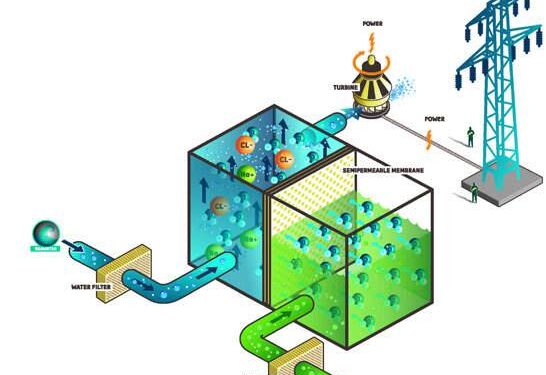In a significant advancement for renewable energy, Japan has officially launched the world’s second osmotic power plant in Fukuoka, marking a pivotal moment in the country’s pursuit of sustainable energy solutions. This innovative facility harnesses the natural osmotic pressure difference between freshwater and seawater, promising a cleaner and more efficient method of energy generation. As global energy landscapes shift and crude oil prices fluctuate, this development not only highlights Japan’s commitment to reducing reliance on fossil fuels but also signals potential shifts in the energy market dynamics. The launch comes at a time when industries are increasingly seeking alternatives to traditional energy sources, and all eyes now turn to how this cutting-edge technology may influence both local and global energy strategies.
Japan’s Innovative Step Towards Sustainable Energy with Second Osmotic Power Plant in Fukuoka
In a significant leap towards renewable energy, Japan has inaugurated the world’s second osmotic power plant in Fukuoka, a development that underscores the nation’s commitment to sustainable energy solutions. This facility is designed to harness the energy produced by the difference in salt concentration between freshwater and seawater, a method that promises a more sustainable alternative to fossil fuels. Unlike traditional hydroelectric plants, osmotic power systems operate with minimal ecological disruption, enabling them to be integrated into various environments without significant adverse effects.
The innovative power plant is expected to generate sufficient energy to power thousands of homes while contributing to Japan’s goal of reducing its carbon footprint. Key features of this groundbreaking facility include:
- Eco-Friendly Technology: Utilizes natural osmotic pressure to generate energy.
- Increased Energy Security: Diversifies Japan’s energy portfolio, reducing reliance on imported fossil fuels.
- Job Creation: Anticipated economic boost through new employment opportunities in the clean energy sector.
As the country continues to face challenges in its energy supply chain, the successful implementation of this osmotic power technology could set a precedent for future projects. With ongoing advancements and investments in renewable infrastructure, Japan aims to emerge as a leader in innovative energy solutions.
Impact of Osmotic Power Technology on Global Energy Markets and Crude Oil Prices
The launch of Japan’s second osmotic power plant in Fukuoka represents a significant milestone in the renewable energy landscape, particularly in the context of global energy markets. This innovative technology, which harnesses the energy produced by the interaction between salt and fresh water, has the potential to reshape energy production dynamics. As countries increasingly seek to diversify their energy portfolios and reduce reliance on fossil fuels, osmotic power could emerge as a viable alternative, driving down demand for traditional energy sources such as crude oil. Analysts suggest that as such technologies continue to develop, we may witness shifts in investment patterns and market strategies in the energy sector.
Additionally, the economic implications of osmotic power development cannot be overlooked, especially in relation to crude oil prices. The introduction of efficient renewable energy sources may help stabilize or even decrease oil prices in the long run if adoption rates increase globally. Key factors that could influence these trends include:
- Increased energy independence: Countries leaning towards renewable sources may find less need for oil imports, affecting global demand dynamics.
- Technological advancements: Improvements in osmotic power technology could lead to reduced costs and higher energy outputs, further encouraging adoption.
- Government policies: Incentives for renewable energy production could greatly influence market strategies and oil consumption patterns.
In light of these developments, market participants will need to monitor the impact of renewable technologies like osmotic power on overall energy demand and crude oil pricing strategies closely, as the energy landscape continues to evolve rapidly.
Future Prospects and Strategic Recommendations for Expanding Renewable Energy Sources in Japan
Japan’s recent advancements in osmotic power technology signal an exciting new chapter for the nation’s renewable energy landscape. To build on this momentum, strategic investments in research and development are essential. Government incentives could encourage innovation in osmotic energy and other renewable sectors, leading to breakthroughs that drive costs down and efficiency up. Additionally, fostering public-private partnerships will be crucial in enhancing technological advancements and scaling production capacities. There is a need to prioritize the exploration of hybrid systems that combine osmotic power with other renewables such as solar and wind, maximizing energy outputs and ensuring a stable supply. Furthermore, integrating smart grid technologies can help optimize energy distribution, making it easier for consumers to access and utilize renewable sources.
To ensure the sustainable expansion of renewable energy, Japan should also focus on community engagement and education initiatives aimed at raising awareness of renewable energy benefits. Local governments can play a pivotal role in promoting grassroots projects that incorporate renewable technologies in urban planning. Establishing a favorable regulatory framework will reduce the bureaucratic hurdles currently faced by renewable energy developers, thus accelerating project timelines. Moreover, targeting investment in the development of energy storage solutions will bolster resilience against fluctuations in renewable energy supply. Below is a summary of key strategic recommendations:
| Recommendation | Action Steps |
|---|---|
| Investment in R&D | Increase funding for osmotic and hybrid energy systems. |
| Public-Private Partnerships | Encourage collaborations to enhance technological development. |
| Community Engagement | Launch educational campaigns to promote renewable energy benefits. |
| Regulatory Framework | Streamline processes to support faster project approvals. |
| Energy Storage Solutions | Invest in advanced technologies to improve energy reliability. |
Wrapping Up
In conclusion, Japan’s inauguration of the world’s second osmotic power plant in Fukuoka marks a significant stride towards sustainable energy generation and a reduction in reliance on fossil fuels. As nations grapple with the escalating challenges posed by climate change and fluctuating crude oil prices, this innovative facility exemplifies the potential of alternative energy solutions. By harnessing the osmotic pressure between saltwater and freshwater, Japan positions itself at the forefront of renewable energy technology. As the global energy landscape continues to shift, the success of this osmotic power initiative may offer critical insights and pave the way for further advancements in clean energy. With the world watching, the outcomes of this groundbreaking project could redefine energy strategies, not just for Japan, but for countries worldwide aiming to balance economic growth with environmental sustainability.













